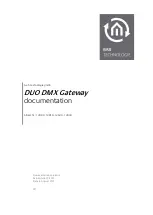
Appendix
29
Doc No: UMAN\GWY-300-B\0106
REVISION 0
5.
HART communication is command based, i.e., a master issues a command and the slave responds. Three
types of HART commands provide read/write access to information available in HART-compatible field instruments.
Universal and Common Practice Commands are defined in the HART protocol specifications. The third type, Device
Specific Commands, provide freedom for product specific parameters or functions unique to a particular device.
Universal Commands ensure interoperability across the large and growing base of products from different
suppliers, and provide access to information useful in normal plant operation, i.e., reading process measurements/
variables, upper and lower range values, and other information such as manufacturer, model, tag, and description. A
basic rule of the HART protocol is that HART-compatible slave devices must respond to all Universal Commands.
These commands are powerful as for example, Universal Command 3 allows up to four dynamic variables to be
read in a single command response.
Device status information included in every HART command response provides increased system integrity for
critical loops. The device status bits in each reply message indicate device malfunctions or other problems such as
analog output saturated, variable out of limits, or communication errors. Some HART-compatible devices can
monitor the device status bits continuously and provide early warning alarms or shutdowns if problems are
detected.
Device Description Language:
HART Device Description Language (DDL), extends interoperability beyond the Universal and Common Practice
commands. A field device (slave) manufacturer uses DDL to create a software file with all relevant device
characteristics, such that a DDL capable host can fully communicate with the device. A Device Description (DD) for
a HART device is analogous to a printer driver in the personal computer world where the printer driver links an
application to the printer such that it prints properly on the page. Universal hand-held communicators capable of
configuring any HART-based instrument through DDL are available from several manufacturers. Other host
applications that understand DDL are beginning to emerge. A central library of all HART-compatible Device
Descriptions is managed by the HART Communication Foundation.



































